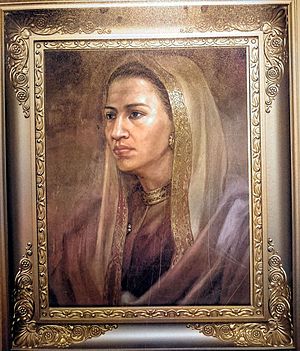Taj ul-Alam facts for kids
Quick facts for kids Taj ul-Alam Safiatuddin Syah |
|||||
|---|---|---|---|---|---|
 |
|||||
| Sulṭāna of Acèh Darussalam | |||||
| Reign | 18 February 1641 - 23 October 1675 | ||||
| Predecessor | Iskandar Thani | ||||
| Successor | Nurul Alam Naqiatuddin Syah | ||||
| Queen consort of Acèh Darussalam | |||||
| Tenure | 27 December 1636 - 15 February 1641 | ||||
| Predecessor | Kamaliah of Pahang (Putroe Phang) | ||||
| Born | Putri Sri Alam 1612 Banda Aceh, Aceh Sultanate, Ottoman Empire (now Indonesia) |
||||
| Died | 23 October 1675 Banda Aceh, Aceh Sultanate, Ottoman Empire (now Indonesia) |
||||
| Spouse | Iskandar Thani | ||||
|
|||||
| House | Meukuta Alam | ||||
| Father | Iskandar Muda | ||||
| Mother | Kamaliah of Pahang (Putroe Phang) | ||||
| Religion | Islam | ||||
Sulṭāna Taj ul-Alam Safiatuddin Syah (born Putri Sri Alam) was a powerful queen who ruled the Aceh Sultanate from 1641 to 1675. She was born in 1612 and passed away on October 23, 1675. As the daughter of Sultan Iskandar Muda and wife of Sultan Iskandar Thani, she became the fourteenth ruler of Aceh. She was also the first of four women to rule Aceh one after another.
Contents
Becoming Queen of Aceh
Putri Sri Alam Permisuri was her original name. In 1617, her father, Sultan Iskandar Muda, conquered a place called Pahang on the Malay Peninsula. He brought a young prince from Pahang, who would later be known as Iskandar Thani, back to Aceh. This prince was raised as Iskandar Muda's adopted son.
In 1619, when the prince was just nine years old, he married Putri Sri Alam Permisuri. They lived in a special palace next to the Sultan's, called Sri Warna. After her father died, Iskandar Thani became the new Sultan. However, he ruled for only a short time and died on February 15, 1641.
His death caused a lot of trouble among the important leaders of the kingdom. But after three days, everyone agreed that the Sultan's wife, Putri Sri Alam, should become the new ruler.
Queens Ruling Aceh
When Putri Sri Alam became queen, she took the name Sultana Taj ul-Alam Safiatuddin Syah. This name means "world crown, purity of the faith." She was the first of four queens who ruled Aceh between 1641 and 1699.
Having women rulers was quite unusual for a strong Muslim kingdom like Aceh. Some historians believe that the powerful nobles in Aceh wanted to make the royal family weaker. This was because Sultan Iskandar Muda had tried to reduce their power. If this is true, they were successful. During the queens' rule, the Sultan's power mostly stayed within the capital city. The real power was held by local leaders and religious scholars.
However, others think that an old Southeast Asian tradition was more important. This tradition allowed women to inherit power. They believe this is why Taj ul-Alam became queen, not just because nobles wanted to weaken the court. Looking closely at this time, it seems Aceh was still strong. The queens ruled with a "softer" and more flexible style. Aceh managed to stay independent, even when Western powers like the Dutch East India Company were taking over other strong kingdoms in the region.
Dutch Influence in Sumatra
During Taj ul-Alam's reign, Aceh's power outside its main area became smaller. On the Malay Peninsula, Johor was no longer under Aceh's control. Pahang was also given up. However, Aceh still kept Perak, which was important for its tin.
The Dutch East India Company (VOC) really wanted this tin. After some problems, several Dutch people in Perak were killed in 1651. The VOC ships then blocked Aceh's ports for a while. In 1659, a treaty was signed. Half of Perak's tin would go to the VOC. The Dutch also got the only right to trade in Aceh's ports. They were allowed to set up a trading post in Padang on Sumatra's west coast.
But Aceh did not fully follow the trade monopoly part of the treaty. Meanwhile, towns on the west coast started to work with the VOC. In 1663, the Dutch and some unhappy local chiefs signed a secret agreement called the Painan treaty. The next year, in 1664, a Dutch fleet forced Aceh's forces out of the coastal area. Aceh had to deal with more Dutch blockades and sign new treaties.
Even so, many local people on the west coast preferred Aceh's rule over Dutch "protection." So, Aceh's influence lasted for a long time there. On the east coast, Deli broke away from Aceh's rule in 1669.
Queen Taj ul-Alam's Legacy
Despite losing some power, Taj ul-Alam was highly respected by both local and European writers. An old chronicle called Bustanus Salatin described her as a good and religious ruler. It said her qualities made Aceh peaceful and rich. A Dutch observer also said she had a "good-natured but awe-inspiring" way of ruling.
She continued a tradition of strong Islamic learning in the royal court. During her time, many Islamic books were written and much learning took place. This was thanks to good teamwork between the queens and the ulama (religious scholars).
Taj ul-Alam passed away on October 23, 1675. She did not have any children. After her death, her royal family line ended. Another queen, Sultan Nurul Alam Naqiatuddin Syah, became the next ruler. It is not clear how she was related to Taj ul-Alam.
| Preceded by Iskandar Thani |
Sulṭāna of Acèh Darussalam 1641 - 23 October 1675 |
Succeeded by Nurul Alam Naqiatuddin Syah |

